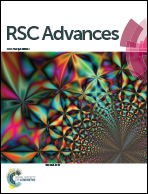Conductive properties and mechanisms of different polymers doped by carbon nanotube/polypyrrole 1D hybrid nanotubes
Abstract
We suggested a method to reduce the amount of multi-walled carbon nanotubes (MWNTs) used for fabricating polymer composites, and revealed the electron transport mechanism in polymer matrixes with different polarities. Specifically, one-dimensional (1D) hybrid nanotubes (MPPy) have been easily prepared by in situ polymerization with an appropriate ratio of pyrrole to MWNTs. Three matrixes including polyvinyl chloride (PVC), poly(methyl methacrylate) (PMMA) and polystyrene (PS) were separately blended mechanically with the MPPy nanotubes. Three families of composites (MPPy/PVC, MPPy/PMMA, MPPy/PS) achieved electrical conductivities higher than 10−5 S cm−1 at 0.3 wt%, 0.8 wt% and 1.5 wt% of MWNTs. The amounts of MWNTs were an order of magnitude lower compared to bare MWNTs used as fillers. The highly ordered chain structure of PPy grown along the surface of the MWNTs might be responsible for the good performance of the MPPy nanotubes, as indicated by FESEM, X-ray photoelectron spectroscopy and Hall Effect Measurement System analysis. We combined the doping effect and tunneling distance to explore the conductive mechanism in the three matrixes. The more potent doping effect and longer tunneling distance in the MPPy/PVC families enabled a sharp improvement of carrier concentration and therefore a lower percolation threshold, compared to that of the MPPy/PMMA and MPPy/PS families.


 Please wait while we load your content...
Please wait while we load your content...